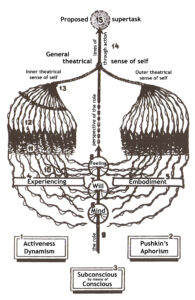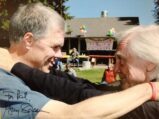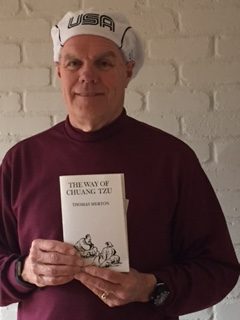 Living the truth occurs when the lawyer is so connected to the truth and their client they have entered into the reality of their client. The lawyer feels what the client feels and thinks like the client thinks. This is short of losing the self. Rather the lawyer’s consciousness and the client’s consciousness meet. (Butler, The Method at xiv). To Stanislavski living the truth is the highest level, the artistic mountaintop that all lawyers should strive to reach.
Living the truth occurs when the lawyer is so connected to the truth and their client they have entered into the reality of their client. The lawyer feels what the client feels and thinks like the client thinks. This is short of losing the self. Rather the lawyer’s consciousness and the client’s consciousness meet. (Butler, The Method at xiv). To Stanislavski living the truth is the highest level, the artistic mountaintop that all lawyers should strive to reach.
Stanislavski instilled in his acting students to serve the truth. The truth is neither philosophical nor political. To Stanislavski the truth is internal. It is the real feeling demanded of the situation. The truth leads to a sense of lived truth to the jury.
Stanislavski taught that concentration and attention help focus the lawyer’s complete physical and spiritual nature on what is going on in the soul. This in turn creates an appearance of not realizing being watched. This is powerful for the jury to see and feel as the lawyer is seen to be immersed in the truth. The secret is to present as real and present experiencing actual emotion. The lawyer introduces themself into the circle of the jury as their world is here with the jury. When the lawyer has belief in their case they have a purpose which makes natural behavior easier to create.
By speaking the truth the lawyer speaks to the needs of the jury because the truth is what we naturally want. The truth is what we see as our common language. The keys to Stanislavski’s system are ACTION, in the given CIRCUMSTANCES, and IMAGINATION. The best trials move from action to action within the given circumstances. Trials deal with problems. To resolve a problem we need action, an object, adjustment and connection. Great trials require the lawyer to do something (action) to something (the object) in a way that takes into account the circumstances (adjustment) made by the scene partner the jury through (connection) and (imagination).
Post Footer automatically generated by Add Post Footer Plugin for wordpress.


 Method lawyering in the words of Constantine Sanislavski is “Living the Truth.” Living the truth as a trial requires me to connect with my client to discover my client’s story. When done methodically I am able to convey from my heart what my client has gone through and how their future holds. My first step in living the truth is to internalize the feelings my client experienced and continues to experience to the point I feel and think like my client.
Method lawyering in the words of Constantine Sanislavski is “Living the Truth.” Living the truth as a trial requires me to connect with my client to discover my client’s story. When done methodically I am able to convey from my heart what my client has gone through and how their future holds. My first step in living the truth is to internalize the feelings my client experienced and continues to experience to the point I feel and think like my client. I recently read The Method by Isaac Butler. The Method was developed by Constantine Stanislavski the great Russian acting philosopher. The book takes Stanislavski from Russia in the early 20th century into the United States where his Method Acting catches fire and Butler continues to discuss American acting into the late 20th century.
I recently read The Method by Isaac Butler. The Method was developed by Constantine Stanislavski the great Russian acting philosopher. The book takes Stanislavski from Russia in the early 20th century into the United States where his Method Acting catches fire and Butler continues to discuss American acting into the late 20th century. Darin Strauss in
Darin Strauss in  Offensive Innovation comes from Gerry Spence and Stephen King. Speaking to experienced trial lawyers at the Trial Lawyer’s College Gerry Spence explained “you have yet to try your first case because you have been practicing law and trying cases in a way that is expected of you.” At the college we learn to take off our mask and proceed how we intuitively know is right.
Offensive Innovation comes from Gerry Spence and Stephen King. Speaking to experienced trial lawyers at the Trial Lawyer’s College Gerry Spence explained “you have yet to try your first case because you have been practicing law and trying cases in a way that is expected of you.” At the college we learn to take off our mask and proceed how we intuitively know is right. Carl Rogers in On Becoming a Person discusses building a relationship. The first step in building a meaningful relationship is to be genuine. This sounds simple but it is not. We often project something we want another to think we are. But this false projection dooms any hope of building a constructive relationship.
Carl Rogers in On Becoming a Person discusses building a relationship. The first step in building a meaningful relationship is to be genuine. This sounds simple but it is not. We often project something we want another to think we are. But this false projection dooms any hope of building a constructive relationship.
 Thomas Merton in THE WAY OF CHUANG TZU writing on how “the central pivot of tao: relates to an artist and craftsman and to all of us in our pursuits:
Thomas Merton in THE WAY OF CHUANG TZU writing on how “the central pivot of tao: relates to an artist and craftsman and to all of us in our pursuits: Dealing with a lying witness will happen to every lawyer who tries cases. Francis Wellman in The Art of Cross Examination (1903) discusses the perjured witness.
Dealing with a lying witness will happen to every lawyer who tries cases. Francis Wellman in The Art of Cross Examination (1903) discusses the perjured witness. Years ago I attended a Day With Paul Luvera where the great trial lawyer quoted Rudyard Kipling’s “Six Honest Serving Men” when discussing cross examination. From
Years ago I attended a Day With Paul Luvera where the great trial lawyer quoted Rudyard Kipling’s “Six Honest Serving Men” when discussing cross examination. From 